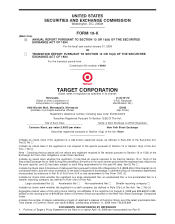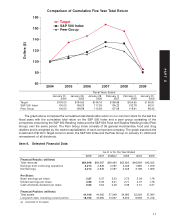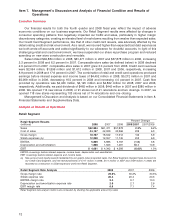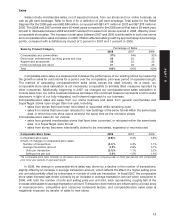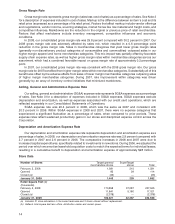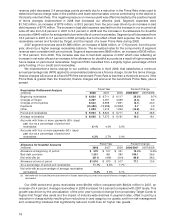Target 2008 Annual Report Download - page 26
Download and view the complete annual report
Please find page 26 of the 2008 Target annual report below. You can navigate through the pages in the report by either clicking on the pages listed below, or by using the keyword search tool below to find specific information within the annual report.services, or stop shopping at our stores altogether. Such events could lead to lost future sales and adversely
affect our results of operations.
Changes in federal, state or local laws and regulations, or our failure to comply with such laws and
regulations, could increase our expenses and expose us to legal risks.
Our business is subject to a wide array of laws and regulations. Significant legislative changes that impact
our relationship with our workforce (none of which is represented by unions as of the end of 2008) could
increase our expenses and adversely affect our operations. Examples of possible legislative changes
impacting our relationship with our workforce include changes to an employer’s obligation to recognize
collective bargaining units, the process by which collective bargaining agreements are negotiated or
imposed, minimum wage requirements, and health care mandates. In addition, certain aspects of our
business, such as our pharmacy and credit card operations, are more heavily regulated than other areas.
Changes in the regulatory environment regarding topics such as banking and consumer credit, Medicare
reimbursements, privacy and information security, product safety or environmental protection, among others,
could cause our expenses to increase. In addition, if we fail to comply with applicable laws and regulations,
particularly wage and hour laws, we could be subject to legal risk, including government enforcement action
and class action civil litigation, which could adversely affect our results of operations.
Given the geographic concentration of our stores, natural disasters could adversely affect our results
of operations.
Our three largest states, by total sales, are California, Texas and Florida, areas where hurricanes and
earthquakes are prevalent. Such events could result in significant physical damage to or closure of one or
more of our stores or distribution centers, and cause delays in the distribution of merchandise from our
vendors to our distribution centers and stores, which could adversely affect our results of operations.
Changes in our effective income tax rate could affect our results of operations.
Our effective income tax rate is influenced by a number of factors, including statutory tax rates, the
valuation of deferred tax assets and liabilities, and, due to the method by which we economically hedge our
deferred compensation liabilities, changes in capital market returns. Changes in the tax laws, the
interpretation of existing laws, or our failure to sustain our reporting positions on examination could adversely
affect our effective tax rate. In addition, our effective income tax rate bears an inverse relationship to capital
market returns due principally to our use of company-owned life insurance as an investment vehicle to
economically hedge our deferred compensation liabilities.
If we are unable to access the capital markets or obtain bank credit, our growth plans, liquidity and
results of operations could suffer.
We are dependent on a stable, liquid and well-functioning financial system to fund our operations and
growth plans. In particular, we have historically relied on the public debt markets to raise capital for new store
development and other capital expenditures, the commercial paper market and bank credit facilities to fund
seasonal needs for working capital, and the asset-backed securities markets to partially fund our accounts
receivable portfolio. In addition, we use a variety of derivative products to manage our exposure to market risk,
principally interest rate and equity price fluctuations. Disruptions or turmoil in the financial markets could
adversely affect our ability to meet our capital requirements, fund our working capital needs or lead to losses
on derivative positions resulting from counterparty failures.
Item 1B. Unresolved Staff Comments
Not applicable
6





